The National Institutes of Health is America’s federal authority on medical research, controlling billions in research funding for universities and research institutions. One of those offices, that you may have not heard much about, is the Office of Research on Women’s Health (ORWH, don’t look for the website just yet). The office was born in 1991 out of efforts to address what it says on the tin: women’s health.
Carefully looking back at the changes on ORWH website provides us with a sort of ice core of just how much gender ideology has influenced the one of the most important scientific institutions in the world. Lets start around some of the first snapshots we can find of the ORWH site.
2004: Halcyon Days
This was a simpler time. Transactivism, while present even decades ago, was not prominent and pervasive as it was in the late 2010s and early 2020s. People would have looked at you like you were crazy if you told them that “men can change into women” was a belief that was going to be taken seriously in the future.
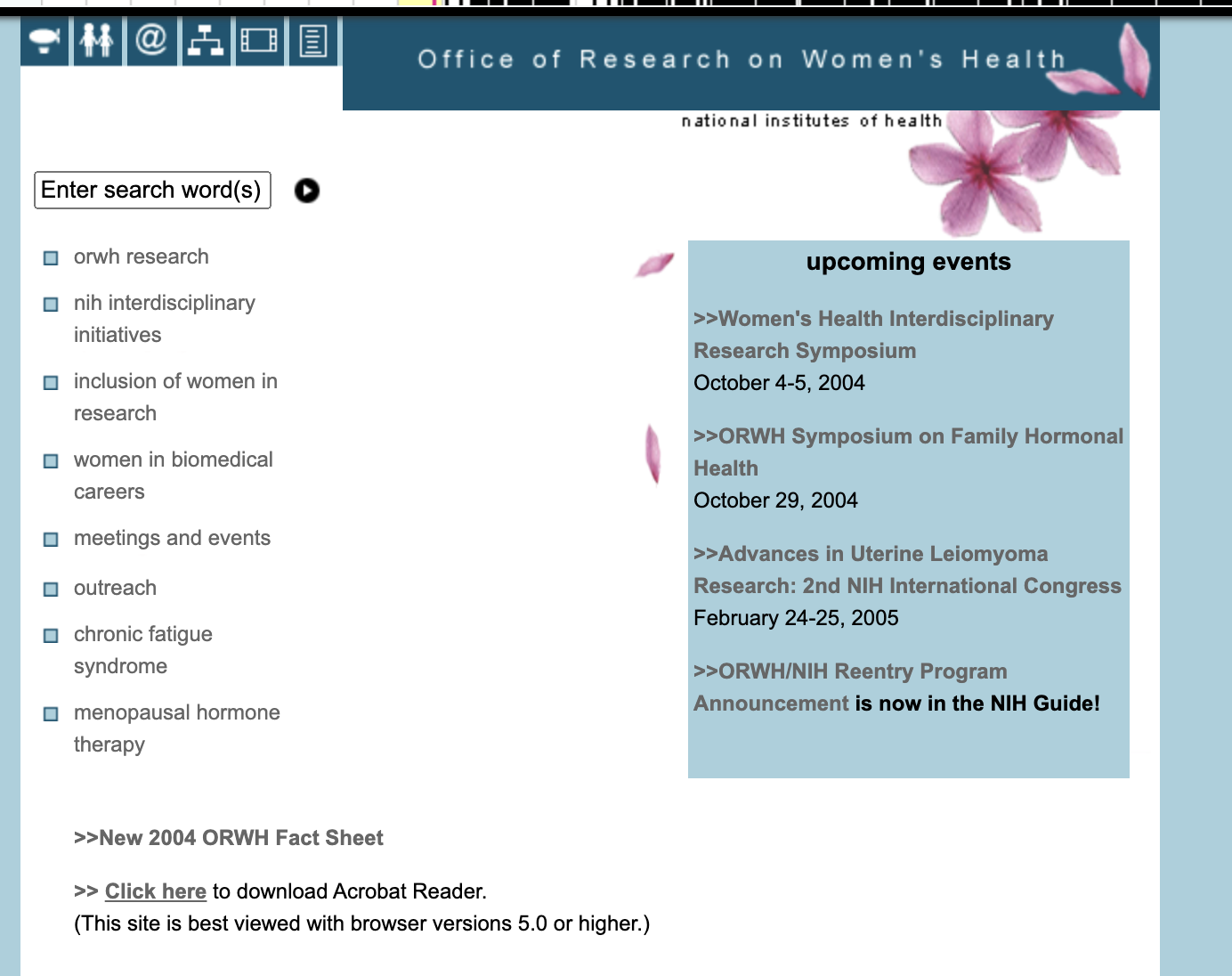
A look at the Research Priorities page is about what most of us (even today) would generally expect to see:
The mission of Office of Research on Women’s Health (ORWH) is to stimulate and encourage meritorious research on women’s health, including sex and gender factors in health and disease. ORWH collaborates with the scientific, health professional and advocacy communities to implement the recommendations from the report, Agenda for Research on Women’s Health for the 21st Century
…
Sex/Gender Determinants Women are characterized by both sex and gender as highlighted in the ORWH Agenda for Research in Women’s Health for the 21st Century and the Institute of Medicine report, entitled Exploring the Biological Contributions to Human Health: Does Sex Matter? Sex factors that contribute to the biological differences include chromosomes, reproduction, and hormones. The effects of gender on psychological, social, and behavioral perspectives are important considerations in most areas of research. Consideration of these variables is critical to the accurate interpretation and validation of research affecting women’s health. Moreover, these variables determine how similar or different health or disease processes may be between women and men.
Written in the clear way we wrote about women in the before times. If there was one place in the government that would have to be serious about knowing what a woman is, you’d presume ORWH would be it. It’s in the name for goodness sake.
The ORWH uses “sex and gender factors” in 2004. It’s clear here that “sex” refers to intrinsically biological factors and gender is related to psychological, social and behavioral “perspectives”. The page cites an overview publication by Vivian W. Pinn, the first director of ORWH, where she emphasizes the importance of consistent terminology and defines the terms sex and gender:
The term sex is used when differences are primarily biological in origin and may be genetic or phenotypic (genetic or physiological characteristics of being a man or woman), and gender is used when referring to social and cultural influences based on sex (Box).
…
Sex: The classification of living things as man or woman according to their reproductive organs and functions assigned by chromosomal complement.
Gender: A person’s self-representation as man or woman, or how that person is responded to by social institutions based on the individual’s gender presentation. Gender is rooted in biology and shaped by environment and experience.
Pretty straightforward and simple. There are two sexes woman/man synonymous with female/male. Gender refers to how a woman might be treated, how she might be expected to behave, what she might wear, how much money she might have etc. based on her sex.
Nowhere on the ORWH or Pimm’s publication do you find contemporary transactivst vocabulary terms like “gender identity”, “transgender”, “transwoman”, “nonbinary” etc. All of the prose is clearly talking about women without any confusion.
2005 to 2017: Steady Waters
The website looks a little different as time goes on, but there don’t seem to be any material changes to the underlying priorities and directions of the ORWH. Just a government website humming along doing its business as usual.
The ORWH website’s 2010 “About” page lists clear definitions of sex and gender:
Promotes, stimulates, and supports efforts to improve the health of women through biomedical and behavioral research on the roles of sex (biological characteristics of being female or male) and gender (social influences based on sex) in health and disease Works in partnership with the NIH institutes and centers to ensure that women’s health research is part of the scientific framework at NIH and throughout the scientific community
Male and female. Gender is still “based on sex”. Makes sense.
In 2012, The about page has removed mention of gender.
History and Mission
The ORWH promotes, stimulates, and supports efforts to improve the health of women through biomedical and behavioral research on the roles that sex (biological characteristics of being female or male) play in health and disease.
Maybe an editor did go through and see how messy the term “gender” was becoming. A new director, Janine Austin Clayton, is appointed this year.
Clayton and the director of the entire NIH, Francis Collins, announce an important directive in 2014 that is pushed across the NIH which was ultimately titled “Sex As a Biological Variable” (SABV). They explain:
Today, just over half of NIH-funded clinical-research participants are women. We know much more about the role of sex and gender in medicine, such as that low-dose aspirin has different preventive effects in women and men, and that drugs such as zolpidem, used to treat insomnia, require different dosing in women and men.
There has not been a corresponding revolution in experimental design and analyses in cell and animal research — despite multiple calls to action. Publications often continue to neglect sex-based considerations and analyses in preclinical studies. Reviewers, for the most part, are not attuned to this failure. The over-reliance on male animals and cells in preclinical research obscures key sex differences that could guide clinical studies. And it might be harmful: women experience higher rates of adverse drug reactions than men do. Furthermore, inadequate inclusion of female cells and animals in experiments and inadequate analysis of data by sex may well contribute to the troubling rise of irreproducibility in preclinical biomedical research, which the NIH is now actively working to address.
The website looks sort of like a normal busy website with drop down menus at the end of 2017.
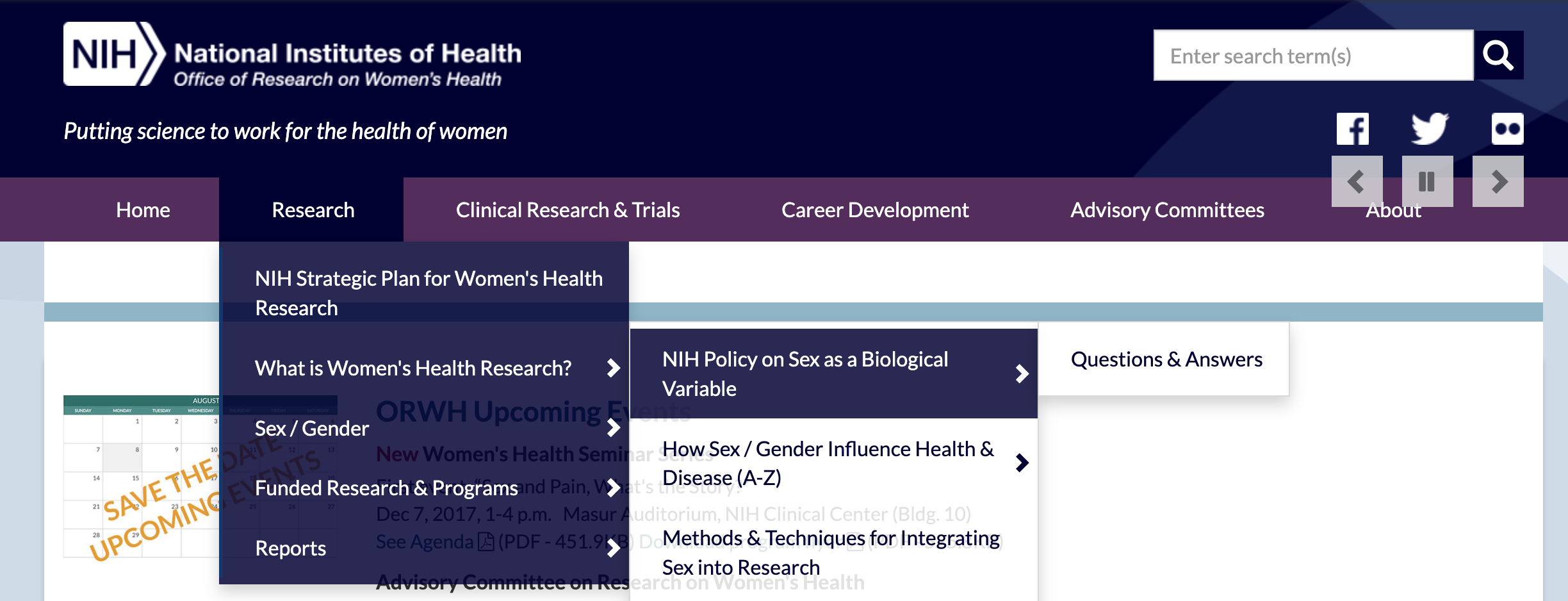
2018: First Cracks
The ORWH creates a handy dandy info graphic that tries to make it easy to tell the difference between sex and gender. It repeats important themes “males have XY chromosomes, females have XX chromosomes”, “each cell is either male or female depending on whether you are a man or a woman” etc. It has a very fluffy definition of gender, but clarifies with useful examples below. I often pointed to this infographic in discussions to show that the NIH seemed to still quite serious about the idea that women are not men and it wasn’t confused on the topic of “sex” in the context of serious medical research that affects the entire world.
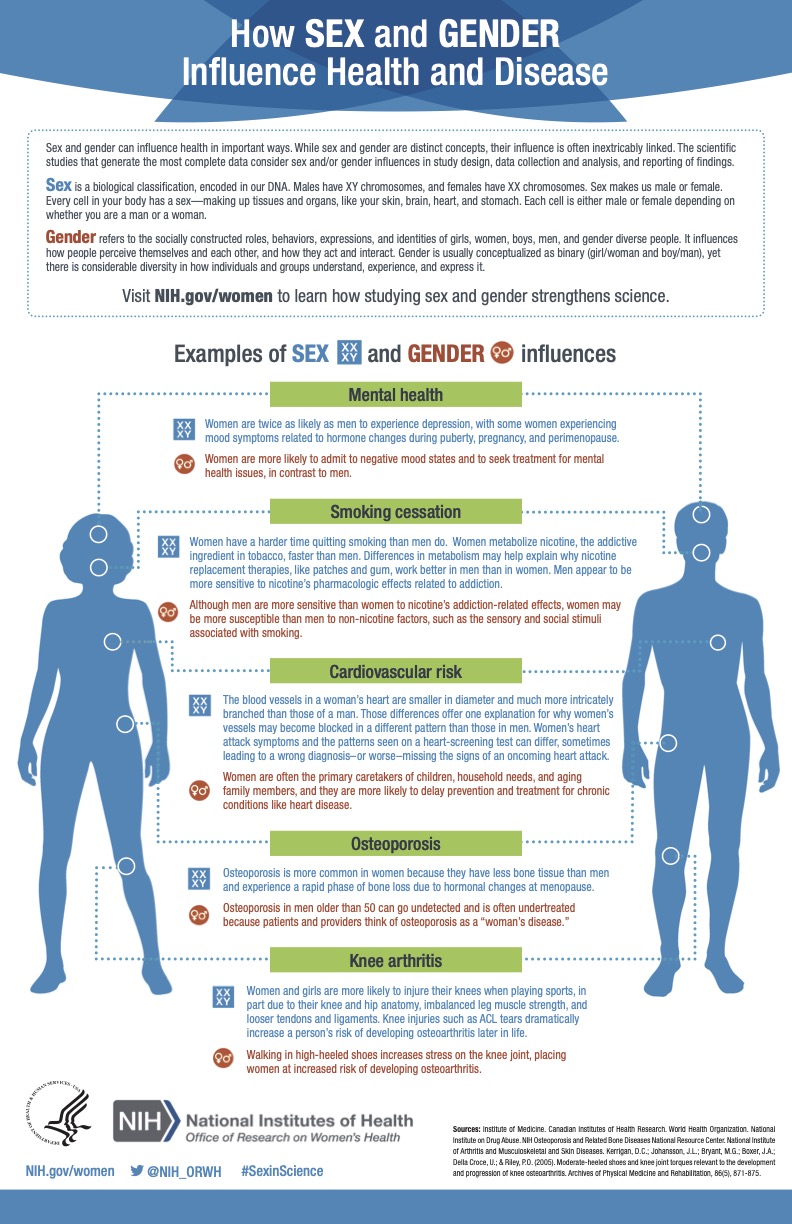
Then, near the end of 2018, the ORWH hosted this
talk by
Nadia Dowshen a “pediatrician and adolescent medicine specialist”, who
provides “specialized care for youth living with HIV/AIDS” and (here
it is) “the medical director of the CHOP Gender and Sexuality
Development Clinic which now provides medical and psychosocial support
to more than 1000 transgender and gender diverse children and
adolescents” (!). Her first slide is a cover of Time Magazine showing
“Laverne Cox” (a man) titled “Transgender Tipping Point”, soon she
says:
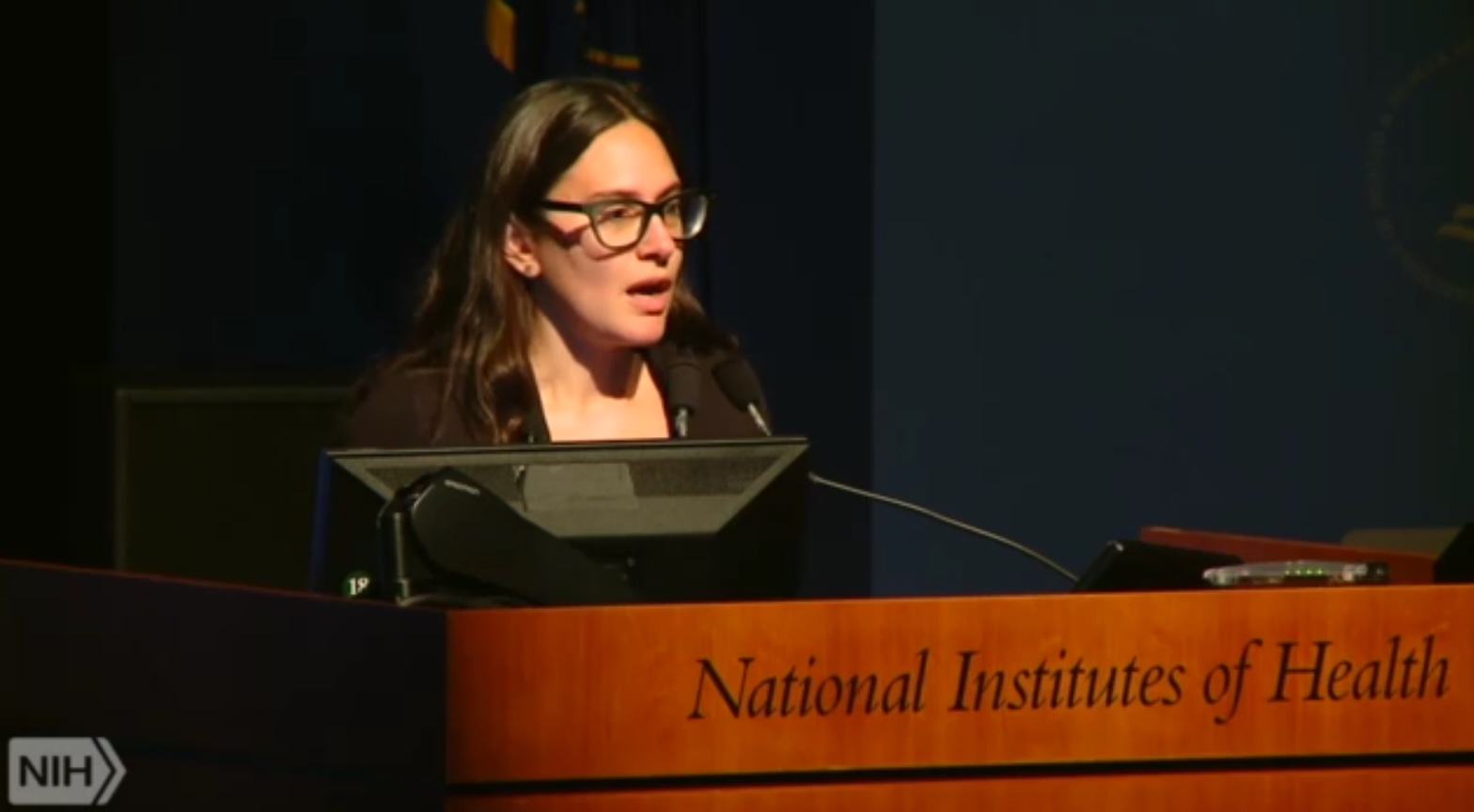
Even if they weren’t coming for HIV care, we would be the ones to see them if they were requesting gender affirming care and were under the age of 24, and when I saw the first patient who came in wanting medical support for their identity, this young person walks in, looking like the captain of the football team which she was when she was in high school but she said that she always felt like she was a cheerleader on the inside and she knew from a very young age that she felt she was a girl and she was looking to me – there without the support of her family and without the support of her community and looking for our support…and when we were able to start her on hormones. That first visit I saw her after, the light just came back into her eyes and she was able to be who she was. I knew this was something i wanted to do for our young people, to be able to support them to be who they are. When I first started doing this care back then, nobody had a clue what i was talking about. Most people in society just didn’t even know what it meant to be transgender and we have had an amazing change in our society in the last ten years or so, that there is a huge increase in awareness and the opening of clinics like ours that take care of kids as young as 4 who are transgender.
It’s hard to overstate how seriously scientific the NIH is in almost every context. Grant reviewers will pick people apart with glee in applications for bad/risky assumptions and mistakes. I think most will admit this is mostly for the best, if a bit brutal, as we are ultimately talking about interventions on human health. In 2018, Dowshen walked into the ORWH and told an audience of scientists that people can be female cheerleaders “on the inside” (male cheerleaders are myth, you clod!), that children as young as 4 can be “transgender” and need invasive treatments that have no good evidence behind them (we all knew this before the Cass review) because you can see “light” in their eyes.
Dowshen is describing her quack thinking delivered with a dose of shameless confidence. I don’t think a single critical question was asked after the talk, like you might expect amongst a group of serious scientists. Imagine if the US Geological Survey invited young earth creationists to give talks…and the audience listened intently…and didn’t bother asking critical questions. That’s what happened here.
We all make mistakes though, perhaps that’s all this was. No need to be concerned it was a sign of things to come…
2019 to 2022: Still Standing
The ORWH site itself remained largely free of gender madness for a while, and these were some peak gender crazy years (during a pandemic no less). The gender critical perspective was demonized, there were notable court cases in many places and many stories of women losing their livelihoods, friends etc. over not being willing to believe the lie that “transwomen are women”. If you look at the “Sex and Gender” page on the ORWH during this time it looks inoffensive.
It was in 2022 the premiere scientific journal in the US, Science Magazine, decided to publish a letter by transactivist men who themselves were trans-identified. These guys had figured out that the ORWH seemed to not be budging with the tide of gender crazy and described women as “menstruating people”, that sex was not binary etc. etc. The letter first cites a paper by Janine Austin Clayton and claims that the NIH’s SABV policy is associated with a “sociopolitical climate has become dangerously hostile to transgender and gender-diverse people”. I don’t remember seeing many young earth creationists being given a slot of publish letters in Science, why did these guys get one? A notable quote:
It is important to recognize the context-dependent and multidimensional nature of sex.
Multidimensional? How many dimensions, exactly? Are they continuous or quantized? What units are those dimensions in? What are the parameters of the underlying distributions exactly? Fingernail scrutiny to these ideas is always catastrophic. Keep the quote above in mind. At the end of 2022, the ORWH still only believed in female/male, woman/man:
NIH is committed to improving health by supporting the rigorous science that drives medical advances. Sex/gender influence health and disease, and considering these factors in research informs the development of prevention strategies and treatment interventions for both men and women.
“Sex” refers to biological differences between females and males, including chromosomes, sex organs, and endogenous hormonal profiles. “Gender” refers to socially constructed and enacted roles and behaviors which occur in a historical and cultural context and vary across societies and over time. All individuals act in many ways that fulfill the gender expectations of their society. With continuous interaction between sex and gender, health is determined by both biology and the expression of gender.
I cannot believe that, by this time, ORWH administrators weren’t aware of the fact that large parts of the US could no longer define “woman”. Giving these ideas any oxygen on public facing pages would have been obscenely self-contradictory.
2023 to 2024: Multidimensional Madness
The ORWH seemed to be able to mostly resist gender madness until now, but in January 2023 we can see the ORWH fold. Note the echoed invocation of multidimensionality:
Sex is a multidimensional biological construct based on anatomy, physiology, genetics, and hormones. (These components are sometimes referred to together as “sex traits.”) All animals (including humans) have a sex. As is common across health research communities, NIH usually categorizes sex as male or female, although variations do occur. These variations are called differences in sex development (DSD) or intersex conditions.
and footnote 3:
Note: (1) Intersex individuals are estimated to make up approximately 1.7% of the population, although some estimates may vary, depending on clinical definitions. (2) Transgender individuals who may have undergone gender-affirming surgery may also have sex traits that do not conform to a single sex.
What did the did the ORWH learn over this month that made them nebulously “redfine” a term that they had been laser focused on for decades? What happened to the importance of consistent terminology and definitions? What categories does the NIH use when it isn’t being its “usual” self? Are there clinical trials that use some “unusual” sex categories? Why can’t I find them?
The DSD/intersex canard is drawn from transactivst lies. These conditions are, naturally, almost always sex specific and all are resolvable into female and male (there is no third gamete type). The 1.7% prevalence (citation missing) is a debunked number put forth by Anne Fausto-Sterling that she herself doesn’t stand behind. That 1.7% prevalence mostly Late Onset Congenital Adrenal Hyperplasia (LOCAH, an often subtle condition) females. The ORWH didn’t feel the need to dignify them as women apparently.
The “gender” section is completely uninterpretable:
Gender is relevant only for research with humans (not other animals). Gender can be broadly defined as a multidimensional construct that encompasses gender identity and expression, as well as social and cultural expectations about status, characteristics, and behavior as they are associated with certain sex traits. Understandings of gender vary throughout historical and cultural contexts.
A person’s gender identity (e.g., woman, man, trans man, gender-diverse, nonbinary) is self-identified, may change throughout their life, and may or may not correspond to a society’s cultural expectations based on their biological sex traits. For example, a person with typical female (sex term) sex traits may or may not be a woman (gender identity). Although gender is often portrayed and understood in Western cultures using binary categories (man or woman) and is often assumed at birth based on a person’s sex traits, many cultures throughout history have recognized a diversity of forms of gender identity and gender expression (how a person communicates their gender to others through behavior and appearance)
What does this even mean? The ORWH demoted its own namesake to a mere “identity”, why don’t these women just identify out their health disparities?
Here is the ORWH crowing how it is funding grants that are trans all over (with an apparent focus on trans-identified males).
How did such an institution as austere as the NIH beclown itself like this?
2025: Purification by Fire
Watching what happened to the ORWH was incredibly depressing. I could not believe something far, far more anti-intellectual than creationism could ever be this successful against an agency that projects itself as no nonsense.
Who would have imagined that an executive order by president Donald Trump would be what saved the ORWH from itself. With the stroke of Trump’s pen, most of the ORWH website had been scorched. The order that clearly defines sex in terms female and male in the federal government, by all accounts of gender critical feminists, is very carefully and correctly crafted. Across other EOs, many hallmark terms from gender ideology are clearly strictly forbidden. These types of threatening actions were clearly the only thing to get places like the ORWH to stop being insane.
At the time of writing the ORWH site is little more than a stub and casually searching and inspecting links suggests that most are not working.
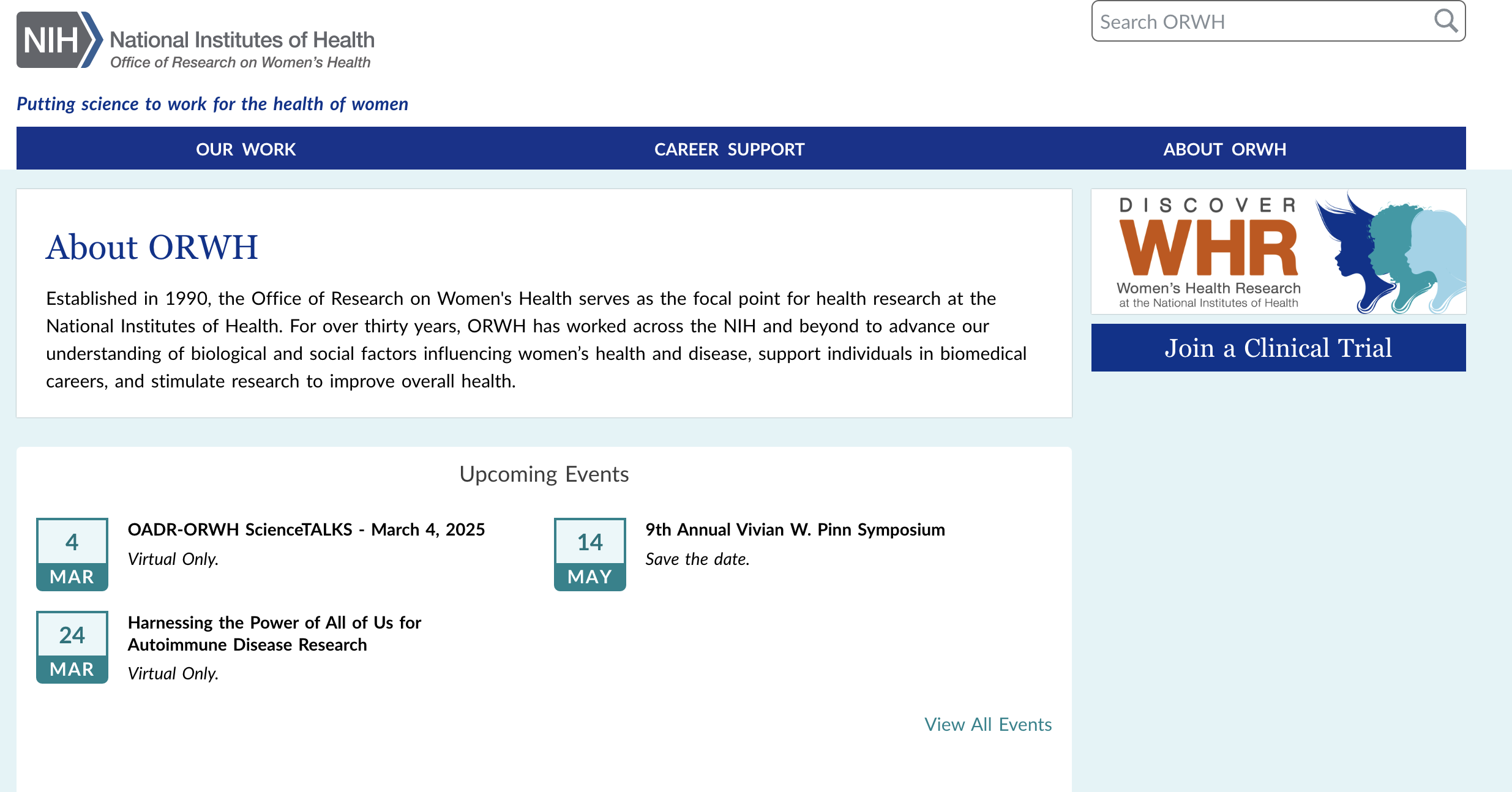
Gender ideology had metastasized so deeply throughout the site that bureaucrats must be working very hard to eradicate all signs of it. Some claim that this is part of a plot to permanently disenfranchise women from resources that would otherwise be available from the ORWH website, but the CDC has already started correcting “pregnant people” and made the pages available.
It’s hard to believe that the ORWH decided to forget what women were. How is the public to trust scientific institutions if they are so vulnerable to shameless dishonesty? Will they ever admit they did this?